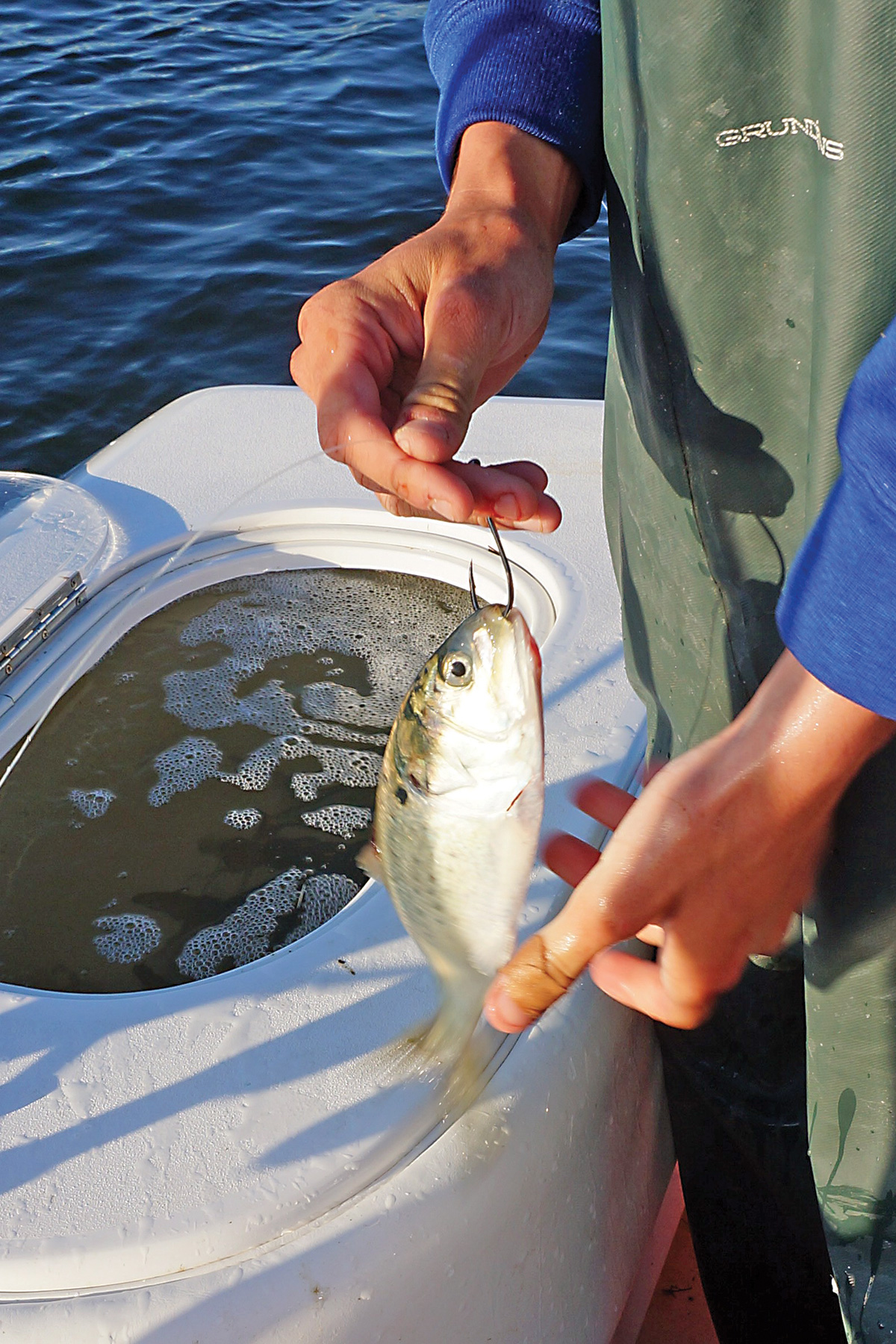
Working hard for live baits pays off in stripers, especially when that bait is hard to find.
Today’s striper fishermen have had it made for many years with an abundance of bunker off our shores in the spring to both attract post-spawning striped bass migrating north while providing the means to catch them—usually right on the spot. At times the sheer volume of bait has seemed to be a problem as those bass can come to the dinner table at any time and don’t have to take your offering among thousands of others. That becomes a completely different story when most of the bunker move on and it becomes a challenge to find them as big bass rarely turn their nose up at a frisky bunker when there are no ready alternatives.
It wasn’t always like that. When I first fished bunker for stripers out of Jones Inlet many decades ago with fellow Freeport Tuna Club member Vic Pastors, that striper pro set out a short gill net where just a few swirls had been spotted, and the few bunker we caught were dumped on the deck to be cast as dead baits to the tips of jetties. A few other pros had been doing that, and we did catch some summer bass in that fashion even though no attempt was made to keep the baits alive.
Good Ol’ Days Are Here
I recall when Capt. Ronnie Lepper ran over from Atlantic Beach to the Jersey side with bunker and found big bass before getting ticketed by the N.J. Marine Police for setting his gillnet in Raritan Bay, where that’s illegal. During a warm weather run of big bass off the Golf Ball (radar dome) at Sandy Hook, boaters would stop at the pound nets inside Sandy Hook Bay to buy adult bunker that were thrown in the fish box to be drifted dead on the bottom in about 40 feet for 30- to 40-pound bass and some even bigger. Compared to whatever I knew about striper fishing from my “schooling” on Cape Cod with such greats as Stan Gibbs, Bob Pond, Bunny Di Pietro, Jimmy Andrews, Capt. Ralph Gray, and Capt. Bud Henderson this was just too easy.
Al Reinfelder, designer of the famous Alou Eel, ran over from Long Island in a small boat, and with a big grin on his face said “This is ridiculous. It’s just like fluke fishing!” That was indeed the case, except that many Jersey anglers were catching the biggest stripers of their lives in their backyard without having to travel to such famed big bass areas as Montauk, Nantucket and Cape Cod.
Gene Graman of Middletown used a deboner to make those bunker look more attractive though it didn’t appear to be necessary. As long as a bunker still had slime and was drifted on or near bottom a big bass would grab it when the bite was on. An egg sinker rig with a long leader to a treble hook in the mouth was a common rig. It wouldn’t have been a big problem to keep some bunkers alive on the way out to that fishery, but I don’t know of anyone who did so.
There were some small schools of bunker in the ocean at that time, but very few in Raritan Bay. Tony Arcabascio who produces the Tony Maja bunker spoons and other striped bass tackle, remembers as a kid growing up in Staten Island that they’d get excited when a dying bunker was spotted so they could wade out and get crab bait. Bluefish were the main species for Staten Island anglers then, except when the weakfish cycle was up. He says it wasn’t until the 1970s that bunker became common in Raritan Bay, and stripers reappeared with them. Great Kills Harbor became a magnet for bunker that could be snagged for live baits, which was so much fun for some charter customers that it was sometimes hard to get them to stop when we had enough to use in the bay only yards away.
Now almost everyone uses cast nets with which to load up quickly. When it comes to striped bass in Raritan Bay, these are the good old days!

Looking for Livies
Big Al Wutkowski and a few other Jersey Shore striper pros worked very hard for every big striper during those days by casting live baits into the jetty tips. They’d do well with live herring caught from local flumes in April, but there were few bunker schools to be found in the ocean after that. Therefore, one boat would make a run from Manasquan Inlet on Monday all the way to the Sandy Hook Bay pound nets and buy 350 live bunker that were placed in a livewell and run back south to be transferred into pens for the week’s fishing. The small schools of bunkers in the ocean were snagged for bait to be brought inshore as Wutkowski said there were only about three days a year around 1990 that they’d find bass under those schools.
When I first brought my Sheri Berri II back from Montauk to Point Pleasant I would join in the effort to find those schools for bait to be used on bluefish and an occasional striper at spots such as Shrewsbury Rocks. That changed when I went out on a September evening and saw a bunker school just south of Manasquan Inlet. I snagged a bunker and transferred it to a single hook rig, but had one after another bitten in half by bluefish. Figuring I might as well catch blues rather than nothing, I switched to a wire leader bluefish chumming hook and a chunk—and immediately caught a 20-pound striper. Strangely, I kept on catching stripers on chunks and wire without any bluefish interference until the bunker school left.
That was certainly an exception to the rule, and the decline in bluefish over the last few years has made live bunker throughout the summer and fall much more practical. I fish frequently out of Highlands with Chuck Many, who is probably the most dedicated striper angler I’ve ever known. From spring through fall, that’s the only species he pursues with his Ty Man. The former ASA Angler of the Year is strictly a release fisherman, and sometimes extends his season by taking the boat to Virginia for the winter fishery.
Many uses eels in Virginia, and usually carries them on his boat throughout the season, but he places no limit on the amount of time and effort he’ll expend in order to carry fresh bunker with him on every trip. Though he lives far away in the northern hills, he often drives down to Highlands the afternoon before fishing just to find the bunker and put some on ice for possible chunking material should they not be where he left them upon returning in the morning—when hours might be spent checking every river and harbor for any sign of them.
The 2018 Run Is On
Bunker have been arriving in Raritan Bay long before stripers in recent years, and netting them for the first trips in April was simply a one throw deal on readings within yards of Many’s slip on the Shrewsbury River. However, by May 1 there were no visible signs of bunker in the bay or ocean. Many had bunker from the previous afternoon when Rob Rommel and I joined him for an afternoon trip at 12:30, but he had to go far up the Navesink in order for Rommel to fill the big circular livewell on the deck. That effort turned out to be well worthwhile as we drifted live baits in shallow water west of the Navy Pier among scattered marks for steady action with surprisingly fussy stripers.
There were spectacular blow-ups on a regular basis, but most didn’t result in hook-ups. A fresh dead bunker and a chunk never got hit. Five bass followed a 5-inch swim shad Many cast, yet none of them hit. We found that switching a bruised live bait for a very lively one often did the trick, but we went through most of what were probably 80 live bunkers quickly before Many decided to make a run to Great Kills for fresh bait. A couple of boats were having trouble netting bait there, but Many got over the sparse readings and Rommel made two throws that refilled our tank with enough to share with other boats.

Returning to the area we had left continued to produce the same sort of action with the fresh baits. The bass were still fussy (I had four hitting my bait for a few minutes, and none of them ever ate it.) but we ended up the afternoon trip with 30 releases up to 33 pounds at a time when most boats had a tough pick after an early morning jigging bite. We must have had a hundred blow-ups to catch that many bass, but it was exciting fishing that wouldn’t have been possible without the effort put in to have a livewell full of lively baits to present to stripers when there wasn’t an abundance of that bait in the fishing area.
Bunker are an even greater attraction to the larger stripers hanging around in the summer; and those stripers usually glomp them down right away rather than playing with them. Even early last fall as a fine run of stripers mostly over 28 inches developed, and shad lures produced great surface action, Many still made the early morning run for live bunkers so we could spend some time working them for stripers in the 20- to 30-pound class in the Hudson River.
The point about bringing live baits to areas where there is no abundance of that species also applies to other fish. When I had my boat at Montauk one summer, IGFA record-holder Capt. Bob Rocchetta got word of a summer mackerel run in the harbor mouth at Block Island. He felt that we should run over there to catch some and bring them back to Montauk Point for stripers, which weren’t very abundant at that time. That’s what we did, and the few mackerel we were able to keep alive were immediately attacked during mid-day at the Porgy Hump by big bass. The same thing applies to even bottom fish baits such as scup (porgies), spot and croakers. Those are also all favorites of Many when he can get them.
It takes a lot of dedication to spend what could be prime fishing time just to seek out bait, which you may never use (such as when a surface lure bite develops), but more often than not it pays off in bigger fish—and often saves the day.




